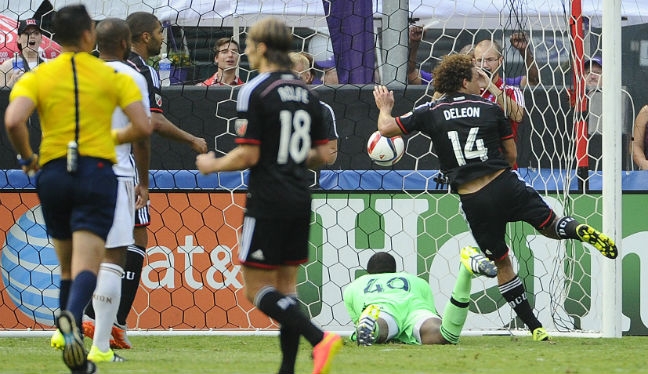Play of the Week 21: Offside – Concentration in D.C. v PHI

By PRO Training & Development Manager Paul Rejer
In this week’s Play of the Week, we analyze an offside call in the game between D.C. Uni
ted and Philadelphia Union – an important sequence which highlights all of the requirements for an assistant referee to make the correct decision.
At 65:10, United are pressing forward when Fabian Espindola takes a shot on goal. The AR, Brian Dunn, has to focus on the following criteria:
– The exact moment the ball is played by Espindola
– The position of the second-last defender
– The position of the attacking players
He is able to see that Alvaro Saborio is, very slightly, in an offside position and Nick DeLeon is in an onside position. However, neither of them have committed an offense as they have not become active by either playing the ball, obstructing an opponent’s line of vision or challenging an opponent for the ball.
The ball is then parried by the Union keeper, Brian Sylvestre, to onside player DeLeon who slots the ball home. Dunn correctly keeps his flag down and the goal is allowed to stand.
This play highlights all of the attributes required for ARs to make high quality correct calls:
– Positioning: he has to be in the optimum position, which is level with the second-last defender, to enable him to see that Saborio is in an offside position and DeLeon is onside
– Body stance: he has to be in a lateral position to keep Espindola in his line of vision
– Concentration: he has to co-ordinate the exact moment the ball is played, with the positions of the two players in conjunction with the second-last defender
– Alertness: he has to be disciplined to keep the flag down, both when the ball is played by Espindola and when it is saved by Sylvestre
– Awareness: the AR has to identify who was onside and who was offside so if the ball goes to Saborio he will raise his flag, but if it goes to DeLeon then he will keep it down
As always, concentration, alertness and awareness are paramount factors fo
r the modern day AR to make correct, accurate adjudications. The margins by which they operate are extremely fine.
When the term ‘benefit of doubt to the attacking team’ was introduced, it was suggested at the time that if there was no daylight between the players then it would be considered onside. This was not official but it was the tolerance by which ARs were judged. As time went by, it changed to half a body, but now it is exactly how the law describes:
In the context of Law 11 – Offside, the following definition applies:
– ‘Nearer his opponents’ goal line’ means that any part of a player’s head, body or feet is nearer to his opponents’ goal line than both the ball and the second-last opponent. The arms are not included in this definition.
As a small part of Saborio’s body is nearer to his opponents’ goal line than both the ball and the second-last defender, he has to be considered in an offside position in this play.
I have often been asked why the tolerances are much tighter in the modern game and my answer is always that ARs have developed their game so well that they are capable of making these accurate calls, so you could say they are victims of their own success.
You can see in this play how focused Dunn remains when the ball is saved by the keeper. He has to be, and he has to display all the vital ingredients I have mentioned above. This is an excellent example of world class assistant refereeing.
